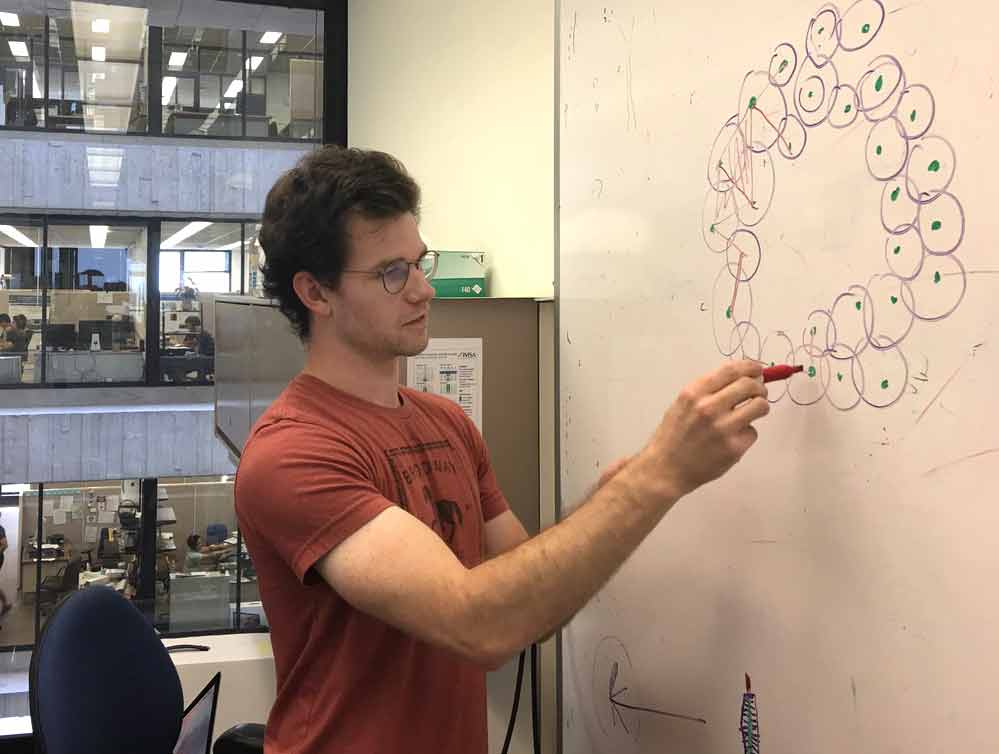Meet a Participant: Jesse Hamer

A mathematician’s dreams of data science: real-world applied mathematics is a big step in intern’s career path
Jesse Hamer hasn’t always known what he’s wanted to do.
Like many students, his interests and career ambitions have changed over time. Initially, he leaned toward nuclear engineering, and then pre-pharmacy. Hamer wandered in science, technology, engineering and mathematics (STEM) fields.
In his third semester of college, he realized something was missing.
“It was my first semester without a math class, and I could tell that something wasn’t right,” Hamer said. “I missed the mind-set math put me in, and the sense of accomplishment I felt from doing it.”
At that point, Hamer resolved to pursue a doctoral degree in pure mathematics, with the intent of becoming a professor.
Hamer obtained a bachelor’s degree in mathematics, and began a doctoral program in pure mathematics at the University of Iowa.
Four years into his doctoral degree, however, Hamer began to wonder if pure mathematics was the exact path for him. With a growing appreciation for applied mathematics, Hamer decided to switch career trajectories from academia to data science. He has taken steps to become an effective data scientist while finishing his degree.
“The National Science Foundation’s (NSF) Mathematical Sciences Graduate Internship (MSGI) Program has been the most important milestone along that path yet,” Hamer said.
The NSF MSGI program offers research opportunities for mathematical sciences doctoral students to participate in internships at national laboratories, industries and other facilities. NSF MSGI seeks to provide hands-on experience for the use of mathematics in a nonacademic setting.
For Hamer, it was the perfect opportunity to explore career possibilities in applied mathematics and data science. Stationed at Fermi National Accelerator Laboratory (Fermilab) near Chicago, Illinois, Hamer began research on artificial neural networks (ANNs), a type of machine learning system inspired by the human brain. ANNs are composed of interconnected processing elements that work in unison to solve specific problems, similar to how neurons work together in the brain to processes information. ANNs learn from examples and observational data, making them able to recognize patterns in complex data sets that would be difficult to detect otherwise.
The use of ANNs has grown explosively in the past decade. ANNs are particularly effective at visual object recognition and natural language processing. They are ideal for large data computing used by entities such as Facebook and Google, as well as facial recognition technology in cellphones.
Despite their popularity, no systematic method or language currently exists to help users effectively choose which type of ANN to utilize to get the best results for their specific need. ANNs have complex structure; the various ways they are structured significantly influences how well they perform.
Under the mentorship of Gabriel Perdue, Ph.D., Hamer sought to make first attempts in establishing a systematic language that describes ANN types for researchers. To do so, Hamer utilized Fermilab’s MINERvA experiment as a case study. MINERvA is a giant detector 200 feet underground designed to study neutrino-nucleus interactions. Hamer analyzed ANNs that were trained on image data of the particle interactions collected by MINERvA.
Hamer used multiple programming languages during his internship. In total, Hamer wrote upwards of 7,000 lines of code and 100 handwritten pages of notes for the project. As a result of his efforts, Hamer was able to design two generic methods for characterizing structural attributes of ANNs, called simple static network attributes and complex static network attributes. The simple static network attributes are computed without reference to the data set on which the ANN is trained, while the complex static network attributes incorporate the original data set. Even if no patterns are uncovered in the methods, Hamer and his mentor hope that the study will spark future interest in creating a language to describe ANN structure. They plan to submit their research to computer science conferences for publication.
“[The program] was fantastic. I only wish I had more time to continue the data analysis that I began. It really is a great opportunity to put pure mathematicians outside of their comfort zone, but with a problem which they still have the skills to approach. I felt valued for my unique perspective as a mathematician,” said Hamer.
Hamer returned to the University of Iowa to finish his doctoral degree. Though Hamer is not sure where he may land as a data scientist—researching at a national laboratory or in the private industry—he appreciates the path he has taken, particularly his internship with NSF MSGI. “It’s a dream come true, honestly, and I cannot be more grateful for the opportunity and experience,” said Hamer.
The NSF MSGI Program is funded by NSF and administered through the U.S. Department of Energy’s (DOE) Oak Ridge Institute for Science and Education (ORISE). ORISE is managed for DOE by ORAU.


